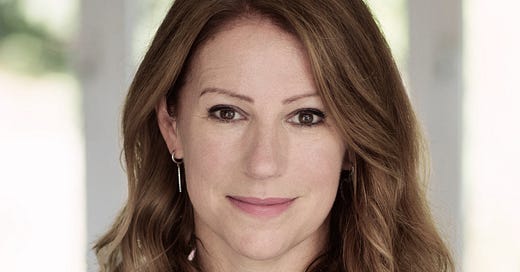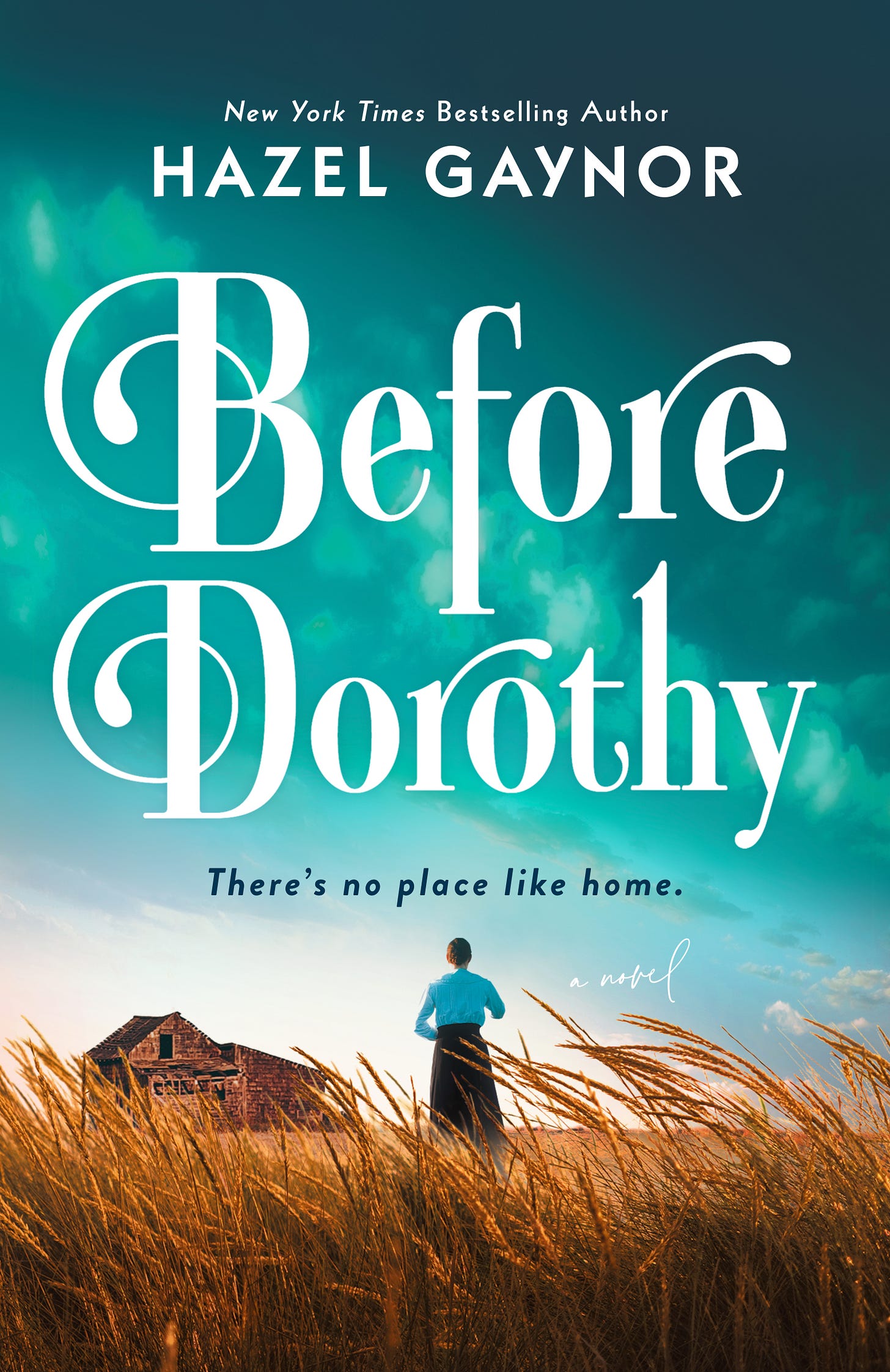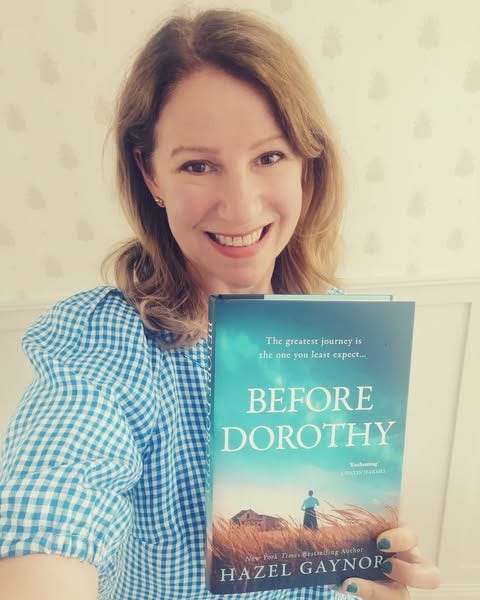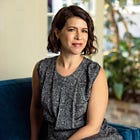CR 051: Hazel Gaynor’s Delightfully Fresh Take on the Wonderful World of Oz
The bestselling historical fiction author discusses her latest novel, “Before Dorothy.”
For years, Hazel Gaynor wanted to write a story related to the Wizard of Oz. As a child in England, she watched the beloved 1939 film every year on Christmas, and later became a fan of Gregory Maguire’s novel Wicked. While still an unpublished author, she attempted to write a contemporary take on the classic tale, but it wasn’t quite right, and her thousands of written words were cast aside.
Years later, with multiple bestselling novels to her name, Gaynor finally realized how to bring her Oz story to life: She would tell the story of Emily Gale—more widely known as Auntie Em. Though a seemingly minor character in both the original L. Frank Baum book and the 1939 film adaptation, Gaynor points out that Emily is actually quite critical to the story. “She’s so pivotal to Dorothy’s longing to return home,” Gaynor says. “It’s Auntie Em who Dorothy cries for when she’s locked in the Wicked Witch’s castle. She shouts for her when she’s in the twister and she’s trying to get into the storm cellar. It’s always about wanting to go home to her.”
In fact, it was the lack of information about Emily in Baum’s book that inspired Gaynor’s latest novel, Before Dorothy. “In the opening chapter,” she says, “he describes her as having first come to Kansas as a young, pretty wife, but the sun and wind had changed her, taken the color from her cheeks and eyes, and she never smiled now. I mean, that’s astonishing. There was an obvious story to be told. What had changed her? Who was she before she’d moved to Kansas? Why had she moved? Why was Dorothy living with her aunt and uncle? Are they indeed her aunt and uncle? There were lots of questions. There isn’t much known about her, and yet she is so crucial to the heroine, Dorothy, who we all know extremely well. It was that gap and having that clue in the original book that gave me goosebumps. I needed to know more.”
Before Dorothy jumps back and forth in time between Emily’s life as a single woman in 1920s Chicago and her life with husband Henry in 1930s Kansas. Like Gaynor’s other works of historical fiction, the novel incorporates factual details, touching upon the 1929 stock market crash, environmental disasters of the 1930s, and the era’s fashion.
I recently chatted with Gaynor about the book’s research and writing process, her love of history, and how self-publishing her first novel kick-started her writing career.
This content contains affiliate links. I am an affiliate of Bookshop.org and I will earn a commission if you click through and make a purchase.
SANDRA EBEJER: Congratulations on Before Dorothy! When you’re working on a book that pulls from an existing franchise like the Wizard of Oz, are there permissions that you have to get?
Not with the book, because the book was written 125 years ago, so that’s in the public domain. Anything that’s referred to in the book you can use in your own fiction. The movie, however, is different. There are certain things within the 1939 movie that are copyrighted, that don’t appear in L. Frank Baum’s book. For example, the ruby slippers. In the original story, the shoes Dorothy are given are silver. In the movie, they were changed to the iconic ruby slippers in order to show off the new brilliant Technicolor technology of the time, and apparently to contrast better against the yellow brick road. So they are copyrighted, as is Miss Gulch, who becomes the Wicked Witch of the West. That character does not exist in L. Frank Baum’s story. There is no Almira Gulch, therefore the Wicked Witch is just a witch. So, there are a few copyright issues, which we had to avoid. But I was always drawn back to the Baum book, the source material.
There is a lot of historical information in the book. What is your research process like? Do you do all the research before you begin writing? Or do you stop writing and research as you go?
A little of both. Initially, you just want to get writing. And I think it’s important to capture that energy on the page, to just let yourself write. My in to writing Before Dorothy was, first of all, to go back to the original Wizard of Oz source material. What do we know and what don’t we know? That was my framework. Lots of re-watches of the movie, which was no hard task at all, and then get to the reality. For me, what was important in this story was that Auntie Em’s story is very grounded in the reality of life. It isn’t a fairy tale. It’s not a mythical land. So I needed to research the eras and the locations. I moved from the 1920s in Chicago to the 1930s in Kansas, through the stock market crash, the Great Depression, and into the Dust Bowl. That was more familiar historical research for me. That’s what I do with all of my books. And that’s [reading] letters, diaries, newspaper articles written from the time. There were photographic records taken of the dust storms and the impact on the land, a documentary that was shown to people at the time—all of that is accessible and gives you a good, clear vision of what it was like for somebody at the time. I always have a vision board. So even looking at, what did the prairie farmers wear? That led me down the road of the feed sack dresses that the women made for their children out of grain sacks that were then patterned and became the iconic blue-and-white gingham check.
It’s a combination of that research—newspaper articles, nonfiction accounts—[and reading] fiction, The Grapes of Wrath [being] the most famous of all the Dust Bowl novels. And really being a historical magpie, trying to assimilate as many different points of view and as broad a knowledge of time and place. That sounds like a lot, but that can be done relatively quickly over the course of, say, six weeks. Then, as I’m writing, I’ll go back to verify or to look into the nitty-gritty detail. So, how are people eating? What’s on the table? What does the house look like? There’s additional layers of research once you’ve got that bedrock, so you know where you are and you’re not being totally out of whack. It’s continual. Even down to final, final, final copy edits, you’re going back and checking. And then you wake up in the middle of the night and are convinced you’ve got something wrong. So, that’s a joy. [Laughs]
It’s interesting that you always have a vision board. Do you typically plot out your stories in advance?
No. I’m a complete pantser, which can be quite alarming at times. I’ve always written that way. I want to write the story and discover it as I’m writing it. With something like Before Dorothy, there is a natural story that you’re following because you’re reimagining something that exists, so there are clues as to what comes next and who’s involved. There were certain milestones within the known world of the Wizard of Oz. But this was about creating a very real world for Dorothy and Emily bedded into the Dust Bowl years in Kansas, so within that I could have gone anywhere. I allow myself to feel the way through the first, second drafts, and then you’re structurally picking it all apart. Things change. Scenes were cut; scenes were added in. That’s how I love writing. It keeps me on the page. Because otherwise it might feel like homework. It’s like, “Ugh, I have to write that chapter.” And sometimes I write out of sequence. If I feel stuck, I’ll go to a scene that’s clearer in my head, and that gets the juices flowing again. It’s sometimes a little hairy when you’re not sure where you’re going next, but it always works out in the end.
You are the third author I’ve interviewed who made the transition from working at a law firm to writing novels. When did your desire to write begin?
This is my second career, and it really came about through a very real-world circumstance of leaving my career behind, not through choice. This isn’t something I ever sat and dreamed about. I’ve always loved stories. I was a voracious reader as a child. I read to my parents before I went to primary school at the age of five, so I was an early reader. Stories were a huge part of my life. And I always loved writing. As I matured, and even in professional careers, I was always the one who would be interested in writing communication. But I didn’t understand how to be a [professional] writer. I didn’t know any writers. I didn’t know anybody in the industry. It seemed like an unattainable thing that other people did and was not for somebody like me.
It was really through circumstance when I left my career and found myself at home with two young children, I started to write about the transition as a blog. Then [I wrote] small pieces for the local newspaper. And through that, I realized I did have stuff I wanted to say. Eventually it transitioned from my story to other people’s stories in fiction. So, it’s from a love of story that I came to be a writer. And being published was just astonishing to me. I’d gone through five years of rejection and hoping, so once it happened, it was an amazing experience. Before Dorothy is my twelfth novel. [It’s] definitely the job I should have been doing. [Laughs] I was a reasonable human resources manager in a law firm, but this is me. This is where my heart is, definitely.
What about historical fiction do you like? Why write about specific events in history rather than just making up a story from your own imagination?
I’m just fascinated. I’ve always loved history. I did history and English literature to A-level at school, then went and did a business degree because I didn’t know what I wanted to be doing. But it’s funny how those two things that I chose to study have both come back to me. I just find the past so interesting. And when you think about a story that reads like fiction because it’s so astonishing and so remarkable, and these hardships that people have endured and have come through, I find that so much more compelling that it actually happened. I get really fascinated and intrigued by the events that have happened in our past, and then to be able to imagine a person planted into that situation. You’re lifting it out of sticking rigidly to the historical events. I think what historical fiction can do is add that human emotion and drama and color to events from the past that can seem a bit distant and literally black and white and static. Obviously, that’s not how it was. They were living in color. They did have the same thoughts, feelings, hopes, fears as we do.
I think fiction allows us to access history that can sometimes feel very distant and remote, and it’s important to keep those stories alive. So, it’s really a fascination with the past. I find it much more compelling than the present. I find the current world utterly bewildering. A lot of the time I’m like, “Why are we doing this?” I wish we could get rid of smartphones. I’m convinced I was born in the wrong decade. A lot of modern life just infuriates me. I would happily go back and do things in different ways. But yeah, it’s naturally where my compass is drawn. I just find it really interesting.
As you were just talking about, many of us think that whatever is happening in the world is unprecedented. We don’t have anything to compare it to, so we don’t think about the fact that people in the past have gone through horrible, sometimes similar, things. Does researching the past and learning about what has come before give you a new perspective about the world we’re living in today?
That’s a really interesting question. I mean, certainly what it does is it shows you that people have been through unimaginable events, hardships, decisions, crises, and have come through them. There’s something about that that’s reassuring. You know, people have been at a stage in their life where they cannot believe what is happening—I think our closest reference is Covid—and at that point, everything shifts and changes. Again, I always try and go back to the source. If you read a diary or a journal or a letter from, say, a woman at the start of the Second World War, there’s this similar sense of disbelief and outrage that all their plans have been disrupted. I think we look back on events as if they’ve already finished, but people living through those events at the time had no time map. They didn’t know the war was going to last for five years. They didn’t know how far that was going to spread. It’s exactly what happened with us with Covid. So I think looking back does help [to see that] when you’re going through difficult times in the modern world, things do move on. I’ve also read an awful lot of accounts where in the worst of times, people become the best of themselves, and that’s fascinating to explore in fiction. I think you understand the past more by learning about those events and you can see, okay, that did come to an end, so hopefully whatever we’re managing will also come to an end. And there are always good things to come out of a crisis, as well as the bad.
You self-published your first novel before then getting a book deal. What did that experience teach you? Would you do anything differently if you could do it all over again?
Well, I wouldn’t do anything differently because it all worked out. [Laughs] Self-publishing The Girl Who Came Home was not what I aimed for when I first started to write that book, which is about the Titanic. Naive as I was, I didn’t realize how long the publication process was. When I presented a finished book about the Titanic a year before the 100-year anniversary in 2012, publishers were telling me, “We’ve already commissioned a Titanic book for 2012 so you’re too late.” So [self-publishing] was a practical option. My agent at the time suggested I self-publish on Kindle. And I literally did that at my kitchen table and pressed publish and went outside to hang the washing on the line. [Laughs] It was very underwhelming. But within the time cycle of the anniversary, that book started to climb up the Kindle charts and that ultimately led to me signing with my now agent who discovered the book online. It couldn’t have gone any better, really.
I mean, there were five years of very gnarly up and down, frustration, rejection, leaving agents. It was messy, which is a lot of authors’ stories. I was very lucky that self-publishing was an option. I had to get that book out because of the events of the anniversary, but also to get it out of my head because it was driving me mad and I couldn’t move on. Once that was out there, it was like, “I’ve done what I can. I’ve done my best.” And I started to write what became my second book, A Memory of Violets. So, creatively, it gave me space. And that then led to me getting a two-book deal with HarperCollins, and that was it. I was off. And as somebody said to me at the time, you only need one yes. All of those noes suddenly melted away, however painful they’d been at the time. So I wouldn’t change a thing, which I’m incredibly fortunate to be able to say.
Who are your influences? Who or what do you turn to when you need some inspiration?
I used to commute in London on the train, and I would always read, and I read several novels by Philippa Gregory, the most famous of which was The Other Boleyn Girl, the story of Mary Boleyn, Anne Boleyn’s sister. It was like, “Who?” [Laughs] I’d grown up being taught English Tudor history and who was Mary Boleyn? So her Tudor court novels were [inspiration]. A light bulb went off in my head because it was history, but it felt like it was happening now because of the way she wrote it. It was like you were walking through the castles with these kings and queens. I’d never read anything like it. Similarly, Tracy Chevalier’s Girl with a Pearl Earring and Rose Tremain’s Restoration and Merivel. I didn’t know they were called historical fiction. They were just great books. But I often go back to them as my touchstones to understanding you can write history in a really contemporary narrative way, and that’s what I hope to do. And before them, there was the influence of the Brontës and Austen and all the classics that I grew up with.
In the author’s note at the end of the book, you shared that after you initially got the idea for what became Before Dorothy, you wrote “thirty thousand or so words,” which have “languished in a drawer ever since.” How often do you find that happens, where you write a lot but have to put it aside because it’s not quite working?
Well, interestingly, those 30,000 words that languished in a draw were the first ever idea I had for a Wizard of Oz reimagining. Totally different story. It was a contemporary reimagining, and that was before I had anything published. That was way back in 2009. So at the time, I happily put it aside because I started writing The Girl Who Came Home, the story about the Titanic. I’ve never revisited those pages because that idea had gone, and I really believe that ideas find the writer at the right time. So although I’d clearly seen something back in 2009 about writing something connected to the Wizard of Oz, I hadn’t settled on the right thing for me. It’s all of these years later, having established myself as a historical novelist, that the Auntie Em idea [came] after two other ideas weren’t really working for my publisher. As soon as I settled on this idea, I knew it was the right one.
That first attempt at a Wizard of Oz reimagining was part of me learning how to be a writer. I think most writers have that sort of learning book. It’s just understanding what it feels like to sit at a desk with an empty page with no promise of anyone ever reading this, and you have to keep writing. There’s a few other pieces along the way that I’ve done a similar 20,000 to 30,000 words but then run out of ideas or energy. I think that’s natural. It’s part of the process and you need to make peace with that. Sometimes you have to take whole chunks out of a contracted book because it isn’t working, and you just need to figure it out. No words are wasted words. They’re all part of getting to the point, whether it’s in a book or in your career, that you’re meant to be. Everything’s part of the journey, although it maybe feels painful at the time.
I usually ask authors what their advice would be for aspiring novelists, but I’d like to ask you what advice you have for anyone who is interested in writing historical fiction.
Well, first of all, read historical fiction. You need to know what that is if you’re interested in writing it. And don’t worry about the research. I think a lot of historical novelists worry, “Is it okay? Can I tell this story? Am I an imposter? Is it okay for me to become an expert in X?” Yes, is the answer. Be passionate about your idea, because it doesn’t matter how much research you do—if you’re not really interested in your idea, that will come out on the page. So be really true to yourself about why you want to write this particular story. And then just get stuck in. Go and do your research. Contact people. People love to tell you what they know about something, so reach out. And don’t limit yourself. Everybody is entitled to write what they like, within reason. Obviously, if you’re going into families who are still living, there’s sometimes permissions. But research and own your story. You’re wanting to write it for a reason, so do.
To learn more about Hazel Gaynor, visit her website.
To purchase Before Dorothy, click here.
This interview has been edited for clarity and length.
You might also enjoy…









